- India
- International
Walking with the migrants, across four states, one story: What do we have here?
As the national lockdown entered its second week, The Indian Express travelled across four states to track this unprecedented exodus, examine what social distancing and isolation means in towns and villages off camera and off the highway — and what could await the first COVID-19 patients here.
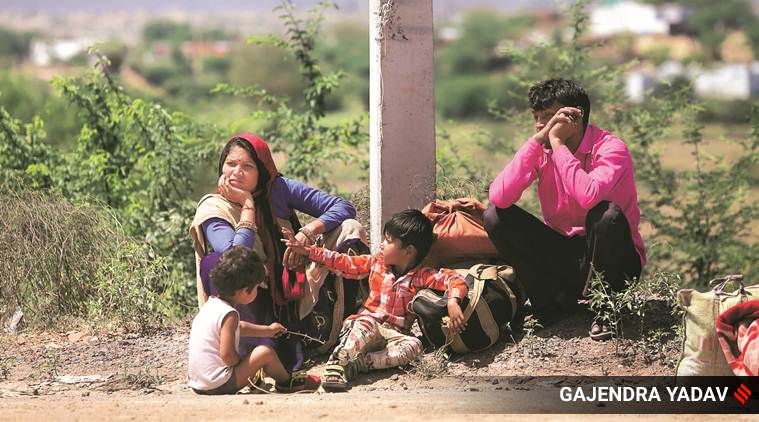 Savitri Bai and her family in Morena, on their way from Agra to Ambah in MP. (Express photo by Gajendra Yadav)
Savitri Bai and her family in Morena, on their way from Agra to Ambah in MP. (Express photo by Gajendra Yadav)
They built homes, offices, even cities. They worked in technology companies. They cooked the food we ate, cleaned the roads we travelled. But now, many of them walk, run, dodge and hide. There are blisters on their feet, and their shoulders hurt from bags and the children.
They are at the Anand Vihar Bus Terminal in Delhi. They are on the Yamuna Expressway in UP. On the Chambal Bridge in MP. On National Highways. On State Highways. They are going home. In the hundreds. Left without work and food in the big cities, they say that’s the only way. Even if borders are shut, a 14-day quarantine awaits and governments, at the Centre and the state, have resolved to lay down the hard line on the lockdown.
As the national lockdown entered its second week, The Indian Express travelled across four states to track this unprecedented exodus, examine what social distancing and isolation means in towns and villages off camera and off the highway — and what could await the first COVID-19 patients here.
At 6.30 am Sunday, on the zero point of the Yamuna Expressway that leads to Agra, Satyendra Singh is tired of waiting. With a red bag slung across his shoulder, he says he began walking at 2.30 am from his rented shack in Noida, near the mobile phone company he worked for. The company is shut, and not just for three weeks, he was told. And it’s been an hour here.
“I cannot afford the rent without pay, and I will run out of money soon,” he says. And so, he began walking. About 7.30 am, a bus pressed into service for the day by the UP government slows down next to him, room only on the roof. A voice shouts out: “Where are you going? Mathura?” “Lucknow,” he says, in disappointment.

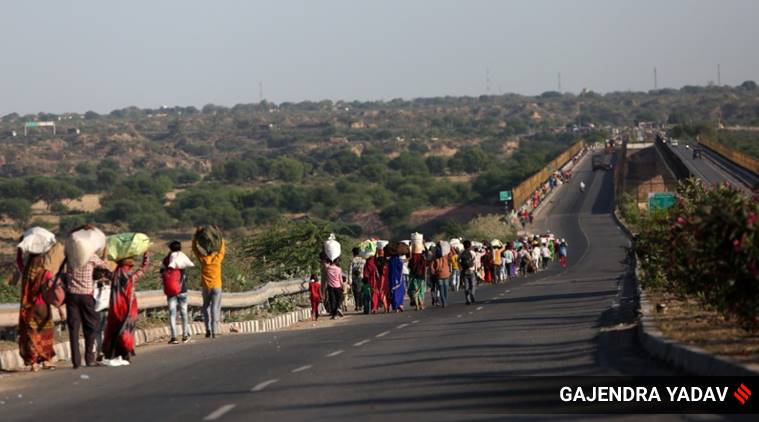 Migrant labourers at Chambal Dholpur Border in Rajasthan after the lockdown. (Express Photo by Gajendra Yadav)
Migrant labourers at Chambal Dholpur Border in Rajasthan after the lockdown. (Express Photo by Gajendra Yadav)
For Singh, Lucknow is only a transit point, a middle ground that gives him hope. Home is Palamu in Jharkhand, over 1,000 km away. Singh points at the speed cameras on the eight-laned “access controlled highway”. “Can they record how fast I am walking?” he laughs. To the left of the cameras, is a signpost draped in irony: “Expressway pe paidal chalna janleva ho sakta hai (Walking on foot on the expressway can be threatening to life).”
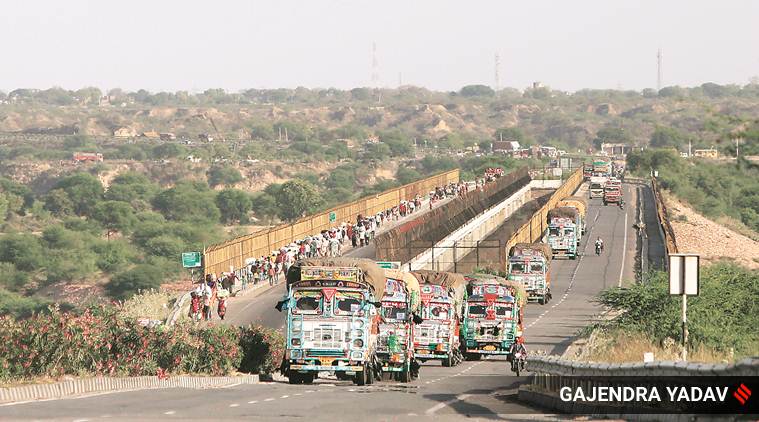 Migrant workers, heading home, cross the Chambal bridge on the Dholpur-Morena border in Madhya Pradesh, Monday. (Express photo by Gajendra Yadav)
Migrant workers, heading home, cross the Chambal bridge on the Dholpur-Morena border in Madhya Pradesh, Monday. (Express photo by Gajendra Yadav)
Two hours later, on the outskirts of Mathura, families sit on the ground next to a police barricade, and three policemen. A group of 30 has just boarded the back of a truck with barely space to breathe. Unable to get on, Mrigendra Jha, a construction labourer, and his family of four get up to walk. So far this morning, the police have been sympathetic: “Why are you walking? How far will you get?” Jha’s response is simple: “Aur raasta kya hai (Is there any other way)? We used to spend what we earned daily. Without that, there is no food for my two children. So we must go home where my family is, and there will be food. Perhaps, someone will give us a ride on a truck to Varanasi and to Samastipur. We will get nowhere waiting here. We must move.”
Read | Migrants turned back at border, many ask: what next?
Between Singh and Jha, Palamu to Samastipur, the anxiety and despair are common: the lockdown caused by the fear of the virus has taken away their daily-wage jobs; with no certainty of what happens next, the home, back in the village, is the only source of succour — economic and emotional.
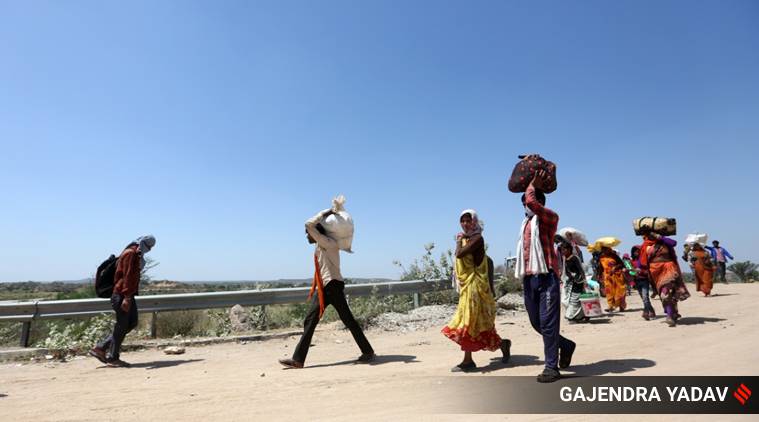 The anxiety and despair are common: the lockdown caused by the fear of the virus has taken away their daily-wage jobs. (Express Photo by Gajendra Yadav)
The anxiety and despair are common: the lockdown caused by the fear of the virus has taken away their daily-wage jobs. (Express Photo by Gajendra Yadav)
This isn’t migration, they had all migrated already from their hardscrabble villages to the cities, this is about returning to the reassuring contours of the familiar, the home in the village they left behind long ago — and will leave once the shadows lift — is now all they look forward to. At least, for the time being.
So by 11 am, the sun is beating down, and police constables at the Dholpur-Morena border, where Rajasthan ends and Madhya Pradesh begins, are sweating. Not from the heat, but the relentless stream of migrant workers. Each one is stopped at the border, and sorted into buses taking them to different districts in Rajasthan. The numbers are overwhelming — 300 to 400 per hour at this one border, says one official.
 A huge crowd of migrant labourers walking to catch the buses bound for Rajasthan borders in Jaipur on Sunday. (Express Photo by Rohit Jain Paras)
A huge crowd of migrant labourers walking to catch the buses bound for Rajasthan borders in Jaipur on Sunday. (Express Photo by Rohit Jain Paras)
In frustration, he asks one group: “Did you think at all before leaving your cities to do this?” Pat comes an exhausted reply from Savitri Bai, from Ambah in Madhya Pradesh who has travelled from Agra: “There is nothing for us in the city. We know Corona is serious. Our village is where we will be able to survive, take care of our families. The rich were allowed back on their planes. Why couldn’t they have allowed trains or buses for two more days? Did the government have a plan?”
At the Rajasthan border, the Assistant Commissioner of Police in charge admits: “As of today, the plan is to take everybody in, and send them to their districts, where they will be screened, and quarantined if necessary. But, the government’s plans keep changing too, and all we can do is to follow directions.”
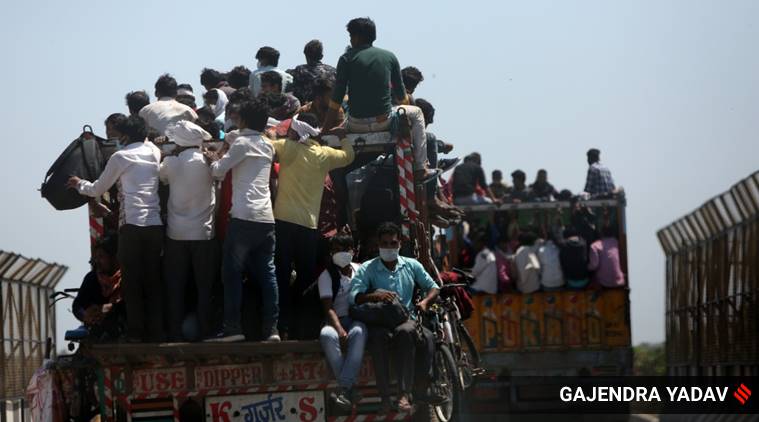 This isn’t migration, they had all migrated already from their hardscrabble villages to the cities, this is about returning to the reassuring contours of the familiar, the home in the village they left behind long ago. (Express Photo by Gajendra Yadav)
This isn’t migration, they had all migrated already from their hardscrabble villages to the cities, this is about returning to the reassuring contours of the familiar, the home in the village they left behind long ago. (Express Photo by Gajendra Yadav)
At the Rarha border post between Rajasthan and Madhya Pradesh close to Bharatpur, a group of men are walking back to their villages, over a 1,000 km away. At the border, they are stopped by policemen who ask: “Why didn’t you stay in Gujarat? The government has already announced that you will get food and shelter where you are? Are you bringing Corona back to your village?” One of the workers, Rannvijay Singh, responds: “I did not live on charity. I worked in a shop in Surat, did honest work, and sent money back to my family. Why should I live in a shelter like a prison? My children are here. Who will take them to hospital if they get sick? In the village, we have farm fields, which will give us food. There is no rent. In the village, the workers from outside have left and gone to their homes. Who will cut the wheat if we don’t?”
Don’t miss from Explained | There’s enough food, but India is struggling to get it to people in COVID-19 lockdown
At 10 pm, at Kosikalan on the Haryana-UP border, a group of 30 men are deboarded from a truck and threatened with legal action. All residents of Hodal in Haryana, they had travelled from Bhopal, evading checkposts before being caught at the last one, 15 km from home. The question thrown at them is one they have heard before: “Pradhanmantri ko sune nahi kya? Baar baar bole rahe hai, ghar mein raho, ghar mein raho? Samajh nahi aa rahi? Yeh bimari khatarnak hai (Did you not hear the Prime Minister? He said again and again, stay at home, stay at home. Do you not understand? This disease is serious).”
The reply — from Rajendra Chauhan, one of the workers — is equally forceful, perhaps from two days of practice. “If Corona comes, and I am to die, can a poor man not even see his family?”
Here’s a quick Coronavirus guide from Express Explained to keep you updated: What can cause a COVID-19 patient to relapse after recovery? | COVID-19 lockdown has cleaned up the air, but this may not be good news. Here’s why | Can alternative medicine work against the coronavirus? | A five-minute test for COVID-19 has been readied, India may get it too | How India is building up defence during lockdown | Why only a fraction of those with coronavirus suffer acutely | How do healthcare workers protect themselves from getting infected? | What does it take to set up isolation wards?
Apr 26: Latest News
- 01
- 02
- 03
- 04
- 05








































